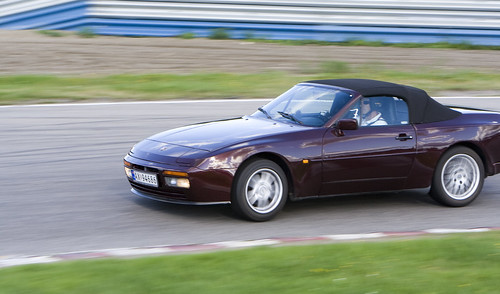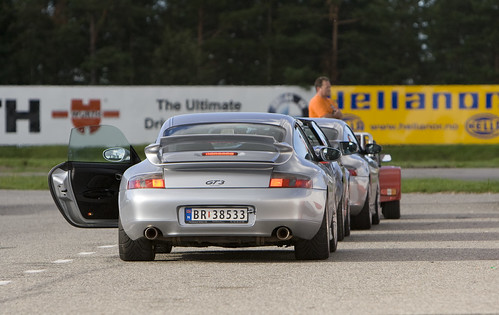As I mentioned on friday, I were going up to Rena to attend this year’s Birkebeinerrittet this saturday. I can now report happily back that I made it all the way through, even though my body felt like every bit of energy was gone even after 30 kms. I’m suspecting that it might have something to do with me feeling a bit sick the previous days, but things seemed better at friday. My body was however probably not prepared for biking 91 kms, but it made it all the way through.
I finished in 5:47, which is quite crap when compared with other people in my age group (25-29), but I conclude that they probably weren’t as happy when they made it to the finish! This means that I reached two of my goals: finish and not die. I’ll leave the 5 hour mark for some other year (avoiding saying next year is a good tactic).
The ride over the mountains were hard, and we started out by climbing the 500 height meters up to Skramstadsetra (you can see the course profile here). After a bit of forrest riding we hit the first downhill part of the track. One person apparently got seriously injuried here during the race, and I can understand why. I’m usually picking up a few spots in the downhill areas, but when you have several hundred riders close by and people approaching quick from the groups starting behind you, there’s no choice but to take it a bit easy. I made it through the downhill, and then we hit the first “time to get off your bike and climb up this mountain in the middle of the forrest” part. There’s no hope of anyone getting up these hills without getting off their bikes, with mud and dirt everywhere and a steep hill. After this things went a bit flat and rough for a while, and I just stuck together with the people around me. Everyone moved at the same speed anyways, so this is not the place to try to make a run for it.
The next part of the course up to Kvarstad went perfectly OK, but I really felt my body draining of any spare energy. Getting a bike GPS is one of the smartest things I’ve bought this year, but when I’m doing long runs, I fall into the trap of looking at it at just a few minutes intervals. Things seem to go sooooo slow… Well, after stretching my legs at Kvarstad, I started on the next climb. Just as I entered the bottom of the hill, my body apparently thought I was joking, so it went for a small shutdown. I just had to get out of the way and spend a minute at the side of the road, before walking the first hundred meters of the hill. Strangest feeling I’ve ever had, and it confirmed my suspicion that I had been a bit sick during the previous days. Should probably have had some more food before starting the race too, but oh well. After walking a bit of the hill, a guy and three girls from Adecco went past at a slower pace, and as the guy humoursly told me that the point were to bike and not walk, I decided to join them at their pace up the hill. This worked out very nicely, and you should know that you helped me up that hill, even though it wasn’t that steep, it was a hard challenge at the time!
After battling through this stage, things went better until we approached the infamous “Rosinbakken” (the hill of the dried grapes / raisins loosly translated). I think the hill got the name because of how your legs feel after finishing it, but it may very well describe the feeling I had in my legs when I got to it. The hill is just over a kilometer long, and it’s inclination is around 10%, meaning that you climb something like 120 meters while riding the hill. Because of the name the hill has been adopted by the company ica, which welcomes you to the hill and then serves you: yep, raisins, halfwall through the hill. I decided to walk here, as my legs were kaput and I still had quite a few smaller hills to attend to in the next kilometers. Got up on my bike for the last 200 meters of the hill as things were flattening out and rode along with a few bikers I had tagged along with earlier. When we got to the top here, things went a lot flatter and the hills got sleeker. Still not anything easy (as you have 58kms+ and somewhere well above 1000 height meters in your legs), but I realized that I were going to make it, and that my body weren’t going to try to shut me down again.
As I approached the last food and drink station, the guys from the elite class were passing us. They started from Rena 2 hours after my starting time, and jeeeeesus. Those guys are fscking fast. Guess the fact that we were close to the highest point of the course also had something to do with it, but seeing people ride like that uphill was very impressive. I’m never going to put down enough time to be able to come close, but a man can dream!
After the last food and drink station there were just a few hills left before we passed sjusjøen, the turning point of the trip. From Sjusjøen almost everything is smooth sailing: the hills go in the right direction (down), the tarmac reappears for several stints and since you now know that all the hard parts are over, your body is ready to contribute the last few strands of energy.
The last part of the track (~6kms) is inside the venue from the 1994 olympics, and the craziest part of the whole track is when you’re going down the hill from the Freestyle skiing event. This is steep. Very steep. Especially when your legs, your arms and your mind is dead tired. This is also where people fall off their bikes, especially if it’s wet and it’s been raining. I just kept my brakes engaged and took the easy way down, slowly descending onto the platform and then riding through the stage where the olympic fire burned for two weeks in 1994. It’s an impressive location and really sets the theme for the finish. A single hill was concealed behind the stadium in a small forest patch, but if you’ve done 90 kms, that’s not going to stop you.
I finally finished after 5 hours and 47 minutes. My parents were there to pick me up, and after getting my diploma and getting off my biking shoes, we set off for home.
Things I’ll remember:
- The two cows we met — in the track — while biking.
- All the sheep. Holy Cow! There’s a lot of sheep in the norwegian mountains.
- Being completely drained of any energy
- All the great people riding, in particular all those who I tagged along the backwheel of. I never thanked you while riding, but it really made a difference. Hopefully you also tagged along when I decided to ride first for some kms, but it seemed hard to get people to catch on. I hope someone else found my back wheel interesting and used it for all it was worth during a couple of kilometers!
- I’d also like to thank in particular:
- A guy from Thales (at least that’s what his backpack said) which I were conversing with through the last 30 kilometers. It really helped! I tried to tag along when you wooshed by together with another group 10 kilometers before the finish, but I lost you after a kilometer.
- The slowest people from Adecco and ica! It’s great seeing people that are attempting to do things they’ve set out to do, and it was of great help all the way.
- A girl in a green outfit, a girl in a blue outfit (both group 65, i think) and the guy and girls in the hill when all energy seemed lost. I know I tagged along your back wheels for maybe a bit more than I should, but it really helped. Hope you all made it to the finish line!
- A guy and a girl from Adecco (also in group 65-67 or something) which rode together. I ended up along with you early on, and then found you again several times along the track. Very inspiring!
- The poor person who had gotten a puncture with just 5 kilometers to go, inside the olympic venue. That’s got to suck.
- The elite guys and their incredible speed!
- The VERY VERY VERY cheerful crowd along the track! You guys cheered, you gave out bananas, you had your own bands, you yelled encouragement. It’s amazing. It really matters. A great thank you to the guy who stood out in the road close to sjusjøen and handed out hi-fives and a gently push on the back to all the amateurs who were just below the top.
- I’ve learnt one thing: you’re always VERY CLOSE to the top of a hill. At least that’s what the crowd are cheering. It doesn’t matter if it’s right, it’ll always feel like it’s true. And when you get to the top, you feel that they were right all along. It wasn’t really that far.
Well. The final question now is if I’d do it again next year. I’m going to wait a few days before I decide, but… probably. Hopefully I’ll have a better couple of weeks before the race.
Anyways: Congratulations to everyone who finished, and if you’re ever considering going for a very nice, well organized mountain bike run in europe, go to Rena and start in Birkebeinerrittet. It’s something everyone should have done at least one time! I’ve now done it twice (in 1996 and in 2008)!



